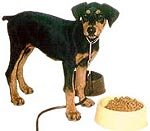NOTE:
Do not tether train a puppy until the
puppy is first "leash" trained at about
10 to 12 weeks of age.
|
Do not use any
physical punishment or
scolding during close tether
training.
The secret to teaching close
tethering is to move your
body towards the dog as a
reward and away from the dog
as a correction.
|
What's in it for me?
When introducing any new
exercise or concept, make sure
you make it in the dog's best
interest to comply. Think about
your dog asking you this
question, "What's in it for
me?" 

NOTE:
Begin close tether training after the
dog has been on a long walk; usually at
the end of the day so you can sit and
read or watch television with the dog
near by.
When first introduced to close
tethering, most dogs will go
through at least one temper
tantrum. The dog may attempt to
get your attention in a variety
of ways including pawing,
whining, barking, rolling, and
other difficult behaviors.
A tired dog will be a more
cooperative dog.
 First, find something soft and
comfortable for the dog to lie
on and provide a special chew
toy when you begin close
tethering. Praise the dog for
being on leash and resting
quietly in a specified place. If
the dog has recently eliminated,
but whines, paws, or begins
other attention-seeking
behavior, tell the dog, "Quiet!"
in a firm but not scolding tone. If he or she
stops the attention-seeking,
immediately praise the dog with
soothing words like "good girl
(or boy)."
First, find something soft and
comfortable for the dog to lie
on and provide a special chew
toy when you begin close
tethering. Praise the dog for
being on leash and resting
quietly in a specified place. If
the dog has recently eliminated,
but whines, paws, or begins
other attention-seeking
behavior, tell the dog, "Quiet!"
in a firm but not scolding tone. If he or she
stops the attention-seeking,
immediately praise the dog with
soothing words like "good girl
(or boy)."
Whenever a dog initially begins
what we will call "fussing," the
first option is to take the dog
outside to the toilet area to
determine if he or she needs to
eliminate. Second, offer some
water or, if it is feeding time,
some dry food (not treats) to
determine if that is what is
needed.
Similar to a child who is
fussy, once the basic needs have
been satisfied, then it is
simply a matter of the dog
learning to be comfortable on
its own.
Positive chew training
Teach the dog
that the best chews are given when he is
close tethered or in the kennel. For
close tethering, provide a mat and
praise quiet, relaxed
behavior. As long as the dog is
lying quietly, praise and reward
this quiet behavior every 30
seconds or so. As the dog
adjusts to the close tethering,
gradually taper the frequency of
praising and rewarding quiet
behavior to every few minutes,
and then offer intermittently.
If the dog begins fussing or
puts on a temper tantrum, the
solution is to simply turn away
so that the dog cannot reach you
or see your eyes. If the fussing
is repeated and expanded,
continue to ignore the dog until
he or she is through the entire
repertoire and finally settles
down. Listen carefully to the
dog. Then, when the fussing
stops, turn and give praise and
reward the dog with eye contact
and attention. If he or she
begins fussing again, turn away.
Freedom is not free
Once the dog is close tether
trained, it means he or she will
lie quietly when tethered to any
person or solid object without
fussing. This is similar to the
horse who is taught to rest
outside of the cowboy's saloon.
Close tethering actually gives
the dog more freedom because now
you can take the dog with you
more places and more often. The
goal is to have the dog tethered
close to you and have him or her
be completely relaxed and at
ease. Close tethering is a
gentle, effective strategy for
teaching acceptable household
manners and preventing household
destruction in addition to
providing a means to spending
more quality time together with
your pet.